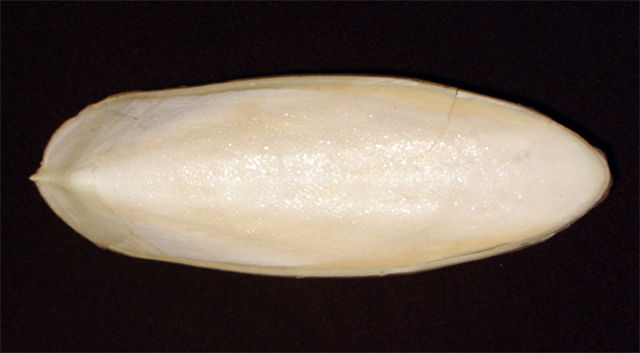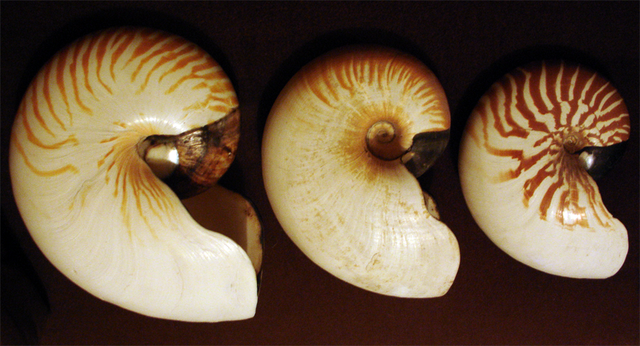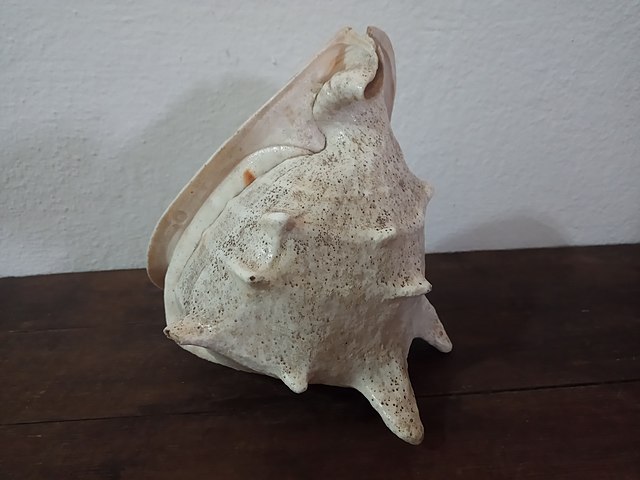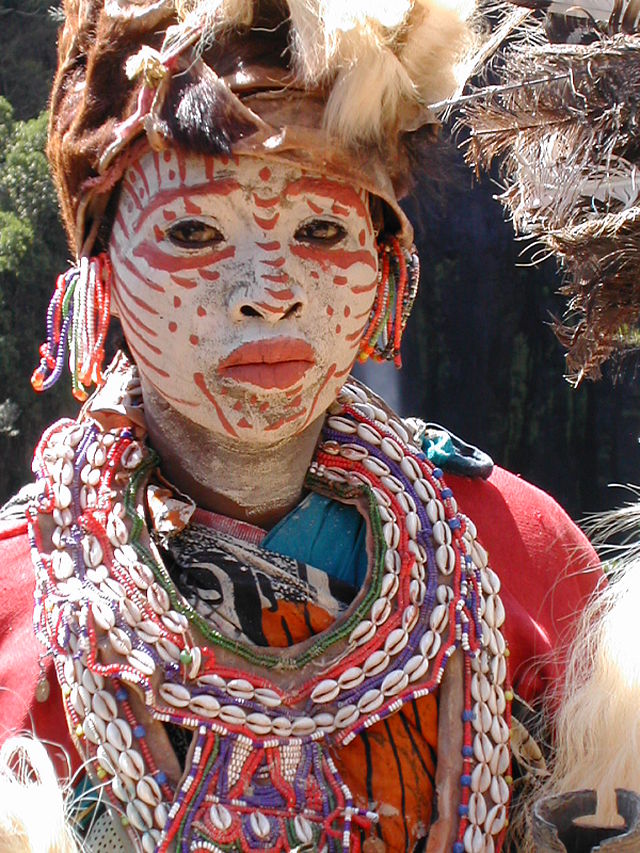Loading AI tools
Hard, protective outer layers created by an animal that lives in the sea From Wikipedia, the free encyclopedia
A seashell or sea shell, also known simply as a shell, is a hard, protective outer layer usually created by an animal or organism that lives in the sea. Most seashells are made by mollusks, such as snails, clams, and oysters to protect their soft insides.[1] Empty seashells are often found washed up on beaches by beachcombers. The shells are empty because the animal has died and the soft parts have decomposed or been eaten by another organism.
This article needs additional citations for verification. (January 2009) |





A seashell is usually the exoskeleton of an invertebrate (an animal without a backbone), and is typically composed of calcium carbonate[1] or chitin. Most shells that are found on beaches are the shells of marine mollusks, partly because these shells are usually made of calcium carbonate, and endure better than shells made of chitin.
Apart from mollusk shells, other shells that can be found on beaches are those of barnacles, horseshoe crabs and brachiopods. Marine annelid worms in the family Serpulidae create shells which are tubes made of calcium carbonate cemented onto other surfaces. The shells of sea urchins are called "tests", and the moulted shells of crabs and lobsters are exuviae. While most seashells are external, some cephalopods have internal shells.
Seashells have been used by humans for many different purposes throughout history and prehistory. However, seashells are not the only kind of shells; in various habitats, there are shells from freshwater animals such as freshwater mussels and freshwater snails, and shells of land snails.
When the word "seashells" refers only to the shells of marine mollusks, then studying seashells is part of conchology. Conchologists or serious collectors who have a scientific bias are in general careful not to disturb living populations and habitats: even though they may collect a few live animals, most responsible collectors do not often over-collect or otherwise disturb ecosystems.
The study of the entire molluscan animal (as well as the shell) is known as malacology; a person who studies mollusks is known as a malacologist.
Seashells are commonly found in beach drift, which is natural detritus deposited along strandlines on beaches by the waves and the tides. Shells are very often washed up onto a beach empty and clean, the animal having already died.
Empty seashells are often picked up by beachcombers. However, the majority of seashells which are offered for sale commercially have been collected alive (often in bulk) and then killed and cleaned, specifically for the commercial trade.[2] This type of large-scale exploitation can sometimes have a strong negative impact on local ecosystems, and sometimes can significantly reduce the distribution of rare species.
Seashells are created by the molluscs that use them for protection.[3] Molluscs have an outside layer of tissues on their bodies – the mantle – which creates the shell material and which connects the shell to the mollusc. The specialized cells in the mantle form the shell using different minerals and proteins.[3] The proteins are then used to create the framework that supports the growing shell. Calcium carbonate is the main compound of shell structure, aiding in adhesion.[3]
This section needs additional citations for verification. (September 2011) |


The word seashell is often used to mean only the shell of a marine mollusk. Marine mollusk shells that are familiar to beachcombers and thus most likely to be called "seashells" are the shells of marine species of bivalves (or clams), gastropods (or snails), scaphopods (or tusk shells), polyplacophorans (or chitons), and cephalopods (such as nautilus and spirula). These shells are very often the most commonly encountered, both in the wild, and for sale as decorative objects.
Marine species of gastropods and bivalves are more numerous than land and freshwater species, and the shells are often larger and more robust. The shells of marine species also often have more sculpture and more color, although this is by no means always the case.
In the tropical and sub-tropical areas of the planet, there are far more species of colorful, large, shallow water shelled marine mollusks than there are in the temperate zones and the regions closer to the poles.
Although there are a number of species of shelled mollusks that are quite large, there are vast numbers of extremely small species too, see micromollusks.
Not all mollusks are marine. There are numerous land and freshwater mollusks, see for example snail and freshwater bivalves. In addition, not all mollusks have an external shell: some mollusks such as some cephalopods (squid and octopuses) have an internal shell, and many mollusks have no shell, see for example slug and nudibranch.

Bivalves are often the most common seashells that wash up on large sandy beaches or in sheltered lagoons. They can sometimes be extremely numerous. Very often the two valves become separated.
There are more than 15,000 species of bivalves that live in both marine and freshwater. Examples of bivalves are clams, scallops, mussels, and oysters. The majority of bivalves consist of two identical shells that are held together by a flexible hinge. The animal's body is held protectively inside these two shells. Bivalves that do not have two shells either have one shell or they lack a shell altogether. The shells are made of calcium carbonate and are formed in layers by secretions from the mantle. Bivalves, also known as pelecypods, are mostly filter feeders; through their gills, they draw in water, in which is trapped tiny food particles. Some bivalves have eyes and an open circulatory system. Bivalves are used all over the world as food and as a source of pearls. The larvae of some freshwater mussels can be dangerous to fish and can bore through wood.
Shell Beach, Western Australia, is a beach which is entirely made up of the shells of the cockle Fragum erugatum.

Certain species of gastropod seashells (the shells of sea snails) can sometimes be common, washed up on sandy beaches, and also on beaches that are surrounded by rocky marine habitat.

Chiton plates or valves often wash up on beaches in rocky areas where chitons are common. Chiton shells, which are composed of eight separate plates and a girdle, usually come apart not long after death, so they are almost always found as disarticulated plates. Plates from larger species of chitons are sometimes known as "butterfly shells" because of their shape.


Only a few species of cephalopods have shells (either internal or external) that are sometimes found washed up on beaches.
Some cephalopods such as Sepia, the cuttlefish, have a large internal shell, the cuttlefish bone, and this often washes up on beaches in parts of the world where cuttlefish are common.
Spirula spirula is a deep water squid-like cephalopod. It has an internal shell which is small (about 1 in or 24 mm) but very light and buoyant. This chambered shell floats very well and therefore washes up easily and is familiar to beachcombers in the tropics.
Nautilus is the only genus of cephalopod that has a well-developed external shell. Females of the cephalopod genus Argonauta create a papery egg case which sometimes washes up on tropical beaches and is referred to as a "paper nautilus".
The largest group of shelled cephalopods, the ammonites, are extinct, but their shells are very common in certain areas as fossils.
Empty molluscan seashells are a sturdy, and usually readily available, "free" resource which is often easily found on beaches, in the intertidal zone, and in the shallow subtidal zone. As such they are sometimes used second-hand by animals other than humans for various purposes, including for protection (as in hermit crabs) and for construction.


There are numerous popular books and field guides on the subject of shell-collecting. Although there are a number of books about land and freshwater mollusks, the majority of popular books emphasize, or focus exclusively on, the shells of marine mollusks. Both the science of studying mollusk shells and the hobby of collecting and classifying them are known as conchology. The line between professionals and amateur enthusiasts is often not well defined in this subject, because many amateurs have contributed to, and continue to contribute to, conchology and the larger science of malacology. Many shell collectors belong to "shell clubs" where they can meet others who share their interests. A large number of amateurs collect the shells of marine mollusks, and this is partly because many shells wash up empty on beaches, or live in the intertidal or sub-tidal zones, and are therefore easily found and preserved without much in the way of specialized equipment or expensive supplies. Some shell collectors find their own material and keep careful records, or buy only "specimen shells", which means shells which have full collecting data: information including how, when, where, in what habitat, and by whom, the shells were collected. On the other hand, some collectors buy the more widely available commercially imported exotic shells, the majority of which have very little data, or none at all. To museum scientists, having full collecting data (when, where, and by whom it was collected) with a specimen is far more important than having the shell correctly identified. Some owners of shell collections hope to be able to donate their collection to a major natural history or zoology museum at some point, however, shells with little or no collecting data are usually of no value to science, and are likely not to be accepted by a major museum. Apart from any damage to the shell that may have happened before it was collected, shells can also suffer damage when they are stored or displayed. For an example of one rather serious kind of damage see Byne's disease.
There are a number of clubs or societies which consist of people who are united by a shared interest in shells. In the US, these clubs are more common in southerly coastal areas, such as Florida and California, where the marine fauna is rich in species.

Seashells are usually identified by consulting general or regional shell-collecting field guides, and specific scientific books on different taxa of shell-bearing mollusks (monographs) or "iconographies" (limited text – mainly photographs or other illustrations). (For a few titles on this subject in the US, see the list of books at the foot of this article.) Identifications to the species level are generally achieved by examining illustrations and written descriptions, rather than by the use of Identification keys, as is often the case in identifying plants and other phyla of invertebrates. The construction of functional keys for the identification of the shells of marine mollusks to the species level can be very difficult, because of the great variability within many species and families. The identification of certain individual species is often very difficult, even for a specialist in that particular family. Some species cannot be differentiated on the basis of shell character alone.
Numerous smaller and more obscure mollusk species (see micromollusk) are yet to be discovered and named. In other words, they have not yet been differentiated from similar species and assigned scientific (binomial) names in articles in journals recognized by the International Commission on Zoological Nomenclature (ICZN). Large numbers of new species are published in the scientific literature each year. There are currently an estimated 100,000 species of mollusks worldwide.

The term seashell is also applied loosely to mollusk shells that are not of marine origin, for example by people walking the shores of lakes and rivers using the term for the freshwater mollusk shells they encounter. Seashells purchased from tourist shops or dealers may include various freshwater and terrestrial shells as well. Non-marine items offered may include large and colorful tropical land snail shells, freshwater apple snail shells, and pearly freshwater unionid mussel shells. This can be confusing to collectors, as non-marine shells are often not included in their reference books.
This section needs additional citations for verification. (July 2016) |
Seashells have been used as a medium of exchange in various places, including many Indian Ocean and Pacific Ocean islands, also in North America, Africa and the Caribbean.

Seashells have often been used as tools, because of their strength and the variety of their shapes.
Because seashells are in some areas a readily available bulk source of calcium carbonate, shells such as oyster shells are sometimes used as soil conditioners in horticulture. The shells are broken or ground into small pieces in order to have the desired effect of raising the pH and increasing the calcium content in the soil.


Seashells have played a part in religion and spirituality, sometimes even as ritual objects.


Seashells have been used as musical instruments, wind instruments for many hundreds if not thousands of years. Most often the shells of large sea snails are used, as trumpets, by cutting a hole in the spire of the shell or cutting off the tip of the spire altogether. Various different kinds of large marine gastropod shells can be turned into "blowing shells"; however, the most commonly encountered species used as "conch" trumpets are:
Children in some cultures are often told the myth that you can hear the sound of the ocean by holding a seashell to ones ear. This is due to the effect of seashell resonance.


Whole seashells or parts of sea shells have been used as jewelry or in other forms of adornment since prehistoric times. Mother of pearl was historically primarily a seashell product, although more recently some mother of pearl comes from freshwater mussels. Also see pearl.
"Sailor's Valentines" were late 19th-century decorative keepsakes which were made from the Caribbean, and which were often purchased by sailors to give to their loved ones back home for example in England. These valentines consisted of elaborate arrangements of small seashells glued into attractive symmetrical designs, which were encased on a wooden (usually octagonal) hinged box-frame. The patterns used often featured heart-shaped designs, or included a sentimental expression of love spelled out in small shells.
The making of shell work artifacts is a practice of Aboriginal women from La Perouse in Sydney, dating back to the 19th century. Shell work objects include baby shoes, jewelry boxes and replicas of famous landmarks, including the Sydney Harbour Bridge and the Sydney Opera House. The shellwork tradition began as an Aboriginal women's craft which was adapted and tailored to suit the tourist souvenir market, and which is now considered high art.[12]
Small pieces of colored and iridescent shell have been used to create mosaics and inlays, which have been used to decorate walls, furniture and boxes. Large numbers of whole seashells, arranged to form patterns, have been used to decorate mirror frames, furniture and human-made shell grottos.

A very large outdoor sculpture at Akkulam of a gastropod seashell is a reference to the sacred chank shell Turbinella pyrum of India. In 2003, Maggi Hambling designed a striking 13 ft (4 m) high sculpture of a scallop shell which stands on the beach at Aldeburgh, in England. The goddess of love, Venus or Aphrodite, is often traditionally depicted rising from the sea on a seashell. In The Birth of Venus, Botticelli depicted the goddess Venus rising from the ocean on a scallop shell.
Sea shells found in the creek and backwater of the coast of west India are used as an additive to poultry feed. They are crushed and mixed with jowar maize and dry fish.[citation needed]
Seashells, namely from bivalves[13] and gastropods, are fundamentally composed of calcium carbonate. In this sense, they have potential to be used as raw material in the production of lime.
Along the Gulf Coast of the United States, oyster shells were mixed into cement to make "shellcrete" which could form bricks, blocks and platforms. It could also be applied over logs.[14] A notable example is the 19th-century Sabine Pass Lighthouse in Louisiana, near Texas.[15]


Many arthropods have sclerites, or hardened body parts, which form a stiff exoskeleton made up mostly of chitin. In crustaceans, especially those of the class Malacostraca (crabs, shrimps and lobsters, for instance), the plates of the exoskeleton may be fused to form a more or less rigid carapace. Moulted carapaces of a variety of marine malacostraceans often wash up on beaches. The horseshoe crab is an arthropod of the family Limulidae. The shells or exuviae of these arachnid relatives are common in beach drift in certain areas of the world.

Some echinoderms such as sea urchins, including heart urchins and sand dollars, have a hard "test" or shell. After the animal dies, the flesh rots out and the spines fall off, and then fairly often the empty test washes up whole onto a beach, where it can be found by a beachcomber. These tests are fragile and easily broken into pieces.

The brachiopods, or lamp shells, superficially resemble clams, but the phylum is not closely related to mollusks. Most lines of brachiopods ended during the Permian-Triassic extinction event, and their ecological niche was filled by bivalves. A few of the remaining species of brachiopods occur in the low intertidal zone and thus can be found live by beachcombers.
Some polychaetes, marine annelid worms in the family Serpulidae, secrete a hard tube made of calcium carbonate, adhering to stones or other shells. This tube resembles, and can be confused with, the shell of marine gastropod mollusks in the family Vermetidae, the worm snails.
A few other categories of marine animals leave remains which might be considered "seashells" in the widest possible sense of the word.
Sea turtles have a carapace and plastron of bone and cartilage which is developed from their ribs. Infrequently a turtle "shell" will wash up on a beach.

Pieces of the hard skeleton of corals commonly wash up on beaches in areas where corals grow.
The construction of the shell-like structures of corals are aided by a symbiotic relationship with a class of algae, zooxanthellae. Typically a coral polyp will harbor particular species of algae, which will photosynthesise and thereby provide energy for the coral and aid in calcification,[16] while living in a safe environment and using the carbon dioxide and nitrogenous waste produced by the polyp. Coral bleaching is a disruption of the balance between polyps and algae, and can lead to the breakdown and death of coral reefs.

The skeletons of soft corals such as gorgonians, also known as sea fans and sea whips, commonly wash ashore in the tropics after storms.

Plant-like diatoms and animal-like radiolarians are two forms of plankton which form hard silicate shells. Foraminifera and coccolithophores create shells known as "tests" which are made of calcium carbonate. These shells and tests are usually microscopic in size, though in the case of foraminifera, they are sometimes visible to the naked eye, often resembling miniature mollusk shells.
Seamless Wikipedia browsing. On steroids.
Every time you click a link to Wikipedia, Wiktionary or Wikiquote in your browser's search results, it will show the modern Wikiwand interface.
Wikiwand extension is a five stars, simple, with minimum permission required to keep your browsing private, safe and transparent.